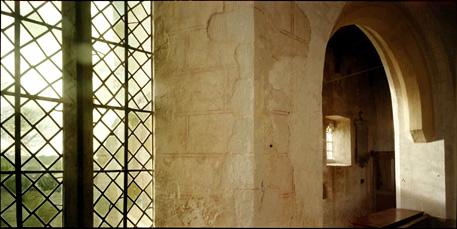
Photograph copyright ©1999 - 2018 Denis Waugh.
External Links
INGLESHAM
A flurry of tiny snowflakes wisped along the ice leaves a delicate fan on the frozen lock water en route to Inglesham. Unreal, monotone countryside, straight from a Rackham illustration, with sepia-toned fields of dead corn, remote brown-brick story-book houses and scribbled trees over ice-white fields. Until the Church of St John the Baptist rises solidly from the riverside mist.
Thank God and William Morris for this beautiful church, saved by the Society for the Protection of Ancient Buildings from renovation in the approved Victorian manner. The powerful nineteenth century Cambridge Camden Society of `Ecclesiologists' saw as it as their function to ensure that `the science of worship' was carried out appropriately in a building of the type pleasing to God, a category strictly limited, apparently, to the Gothic style of the fourteenth century, the Age of Faith. Which is why in the booklet guides to local churches the words `restored in the 1880s' can strike a chill into the heart.
In 1888 Morris and his Society took the Church of St John the Baptist under their wing and insisted that its layers of history be preserved. Thus survives this beautiful and silent testimony to the lives of centuries of English people of divers descents. The church was given by King John to the monks of Beaulieu in 1205, but even then it was over two hundred years old. In the chancel, a stone carving of the madonna and infant revealed by the hand of God could be from the time of Edward the Confessor and the ancient Saxon preaching cross in the churchyard was surely the place from where itinerant priests from a central mother church spoke to the local populace before St John the Baptist of Inglesham was built - certainly well before the Norman Conquest.
Wandering across these frozen fields, with traces of medieval farming visible in the furrowed landscape - it must be wonderful from the air - you can see the appeal the Christian message must have had to these people, beset by poverty, hard grind and, when the local lord so decided, the call to war. Love, forgiveness and eternal rest would have been welcome news indeed.
The interior, with its Jacobean boxed pews, remains much as it was in the time of Cromwell's Commonwealth, but throughout are traces of continual use - from the early thirteenth century the nave, arcades and ochre-coloured wall paintings, still clear despite much over-painting in following ages; from the fourteenth century the north door with its foliate hinges; from the fifteenth the font; from the sixteenth the wooden pews and screens; from the seventeenth the pulpit; from the eighteenth the communion rails; and the Hanoverian Arms of the nineteenth century. The twentieth century's contribution is no less important. It comes from the Churches Conservation Trust who now care for this atmospheric and still consecrated ancient building.
Inglesham was a flourishing village in the heyday of the medieval Cotswold wool industry. In more recent times it was well placed for trade with both London and Bristol during the brief flurry of activity on the Thames and Severn Canal, so soon to be eclipsed by rail transport. The canal joined the Thames at Inglesham Lock, which now comprises the garden of the picturesque Round House on the north bank, the home of the last Inglesham lock keeper.
The village is first mentioned in the year 950, and it probably means `the enclosure or river-meadow of a man called Ingen or Ingin' but it may have been named for King Ine, the `Law Giver' who, according to the Anglo-Saxon Chronicle, built the Minster at Glastonbury and, having succeeded to the Kingdom of Wessex in 688, held it for 37 years, despite engagement in numerous local battles. Or perhaps it was for Ingeld, his brother. The brothers, according to the Chronicle in 855, could trace their ancestry back through `Noah, Lamech, Methuselah, Enoch, Jared, Mahaleel, Cainan, Enos, Seth, Adam the first man who is Christ. Amen.'
Old? Well, you can't argue with that.
Text copyright ©1999 - 2018 Priscilla Waugh.